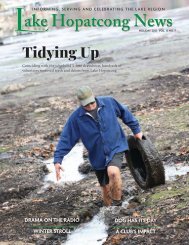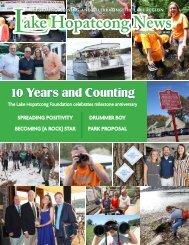Create successful ePaper yourself
Turn your PDF publications into a flip-book with our unique Google optimized e-Paper software.
slime contains toxins that, in certain doses, can<br />
cause rashes and other health effects for humans.<br />
Last year, 65 lakes in New Jersey were affected by<br />
HABs. In New York, the total was 1,189 individual<br />
HAB incidents, the New York Department of<br />
Environmental Conservation reported.<br />
So, what’s happened to reduce the HAB<br />
incidents so far this year?<br />
The simple answer, said Lake Hopatcong<br />
Commission Administrator Colleen Lyons, is this:<br />
“There’s less phosphorus in the lake.”<br />
But nothing is that simple.<br />
Phosphorus is the fuel for the weeds that plague<br />
the lake annually and cyanobacteria, which form<br />
the HABs.<br />
Last year about this time, the lake had achieved<br />
the highest level of phosphorus in 30 years, said<br />
Princeton Hydro Director of Aquatic Resources<br />
Fred Lubnow. The lake must meet a standard of<br />
.03 milligrams of phosphorus per liter of water to<br />
become compliant with environmental rules.<br />
The phosphorus levels during the 2019 growing<br />
season ranged from a high of 0.043 mg/L during<br />
June to a low of 0.017 mg/L during August.<br />
So far through June 2020, of the 11 sites<br />
that are regularly tested, all but one registered<br />
phosphorus levels below the target level of .03<br />
mg/L. Woodport Cove registered at .04 mg/L.<br />
So, less phosphorus.<br />
It didn’t happen by magic.<br />
The water in Lake Hopatcong is a mad scientist’s<br />
brew of chemicals, live and dead plants, aquatic<br />
wildlife and human impact.<br />
For the past 100 years, as the lake’s regional<br />
population grew from a few thousand to more<br />
than 65,000, the annual jousting match between<br />
jurisdiction and the quality of the lake’s water has<br />
occurred.<br />
This particular competition began in 2018, the<br />
year of the last 60-inch drawdown.<br />
That year, instead of fearing the lake would not<br />
refill before the boating season, managers, because<br />
of persistent heavy rainfalls, were regularly<br />
increasing the lake’s outflow to draw the lake back<br />
to the 6.83-foot level required before ice set in.<br />
The pattern of heavy rain continued into the<br />
spring, refilling the lake.<br />
Data from the Office of the State Climatologist<br />
at Rutgers University showed rainfall in Sussex<br />
County in May 2019 measured 8.4 inches. The<br />
30-year average for that month is 3.07 inches. In<br />
Morris County, May 2019 saw 9.16 inches of rain,<br />
compared to the 30-year average of 4.47 inches.<br />
The increased rainfall came with higher<br />
temperatures.<br />
Sussex County in May 2019 averaged 59<br />
degrees, well above the 30-year average of 51.7<br />
degrees. Morris County that month registered an<br />
average 59.9 degrees, above the 30-year average of<br />
58.7 degrees.<br />
The variable weather also was seen in snow<br />
events.<br />
In the winter of 2019-2020, there were<br />
four recorded snow events statewide, between<br />
December 1 and February 20, according to the<br />
climatologist’s data.<br />
Comparatively, in the winter of 2018-2019,<br />
between November 15 and March 3, there were<br />
13 snow events statewide, 11 of which resulted in<br />
measurable snow in the lake region, the weather<br />
data said.<br />
That is important for this reason: More snow<br />
events mean more grit and salt being applied to<br />
the region’s roads.<br />
Ron Tappan, Hopatcong Borough<br />
administrator, noted the difference between the<br />
past two winters in a measurable way: His road<br />
treatment budget is in excellent shape after the<br />
past mild winter.<br />
“We stopped using grit years ago, but last winter<br />
we dealt with only four or five weather events that<br />
required road treatment,” Tappan said.<br />
Less road treatment means the possibility of less<br />
pollution flowing into the lake, he said.<br />
Runoff from roads and lawns and leaching from<br />
septic systems have been identified as the major<br />
source of phosphorus in Lake Hopatcong for<br />
decades.<br />
This element fits into the scenario in this way:<br />
Eleven snow events in 2018-19 resulted in more<br />
road treatment, which potentially washed into the<br />
lake.<br />
Princeton Hydro, in its water quality analysis<br />
for 2019, noted that the lake’s coves were the first<br />
areas affected by a building HAB.<br />
The response to the number of road treatments<br />
was also a factor. Both Morris and Sussex Counties<br />
increased the number of times they swept the<br />
region’s roads in the summer of 2019, potentially<br />
removing more grit, road dirt and salt, reducing<br />
one factor in the pollution of the lake.<br />
In 2020, weather again is a factor, said Lake<br />
Hopatcong Commission Chairman Ronald<br />
Smith.<br />
“It’s been drier and cooler,” he said. “So, we’ll<br />
see.”<br />
The state climatologist data showed that<br />
between June 2019 and May 2020, a rain deficit<br />
was recorded in six separate months, including<br />
Continued on page 12<br />
Free Estimates<br />
(973) 810-3247<br />
rod@woodstairs4u.com<br />
www.woodstairs4u.com<br />
New Construction • Stairs Remodeling<br />
Metal or Wood Balusters • Cable Rail<br />
lakehopatcongnews.com 11

















